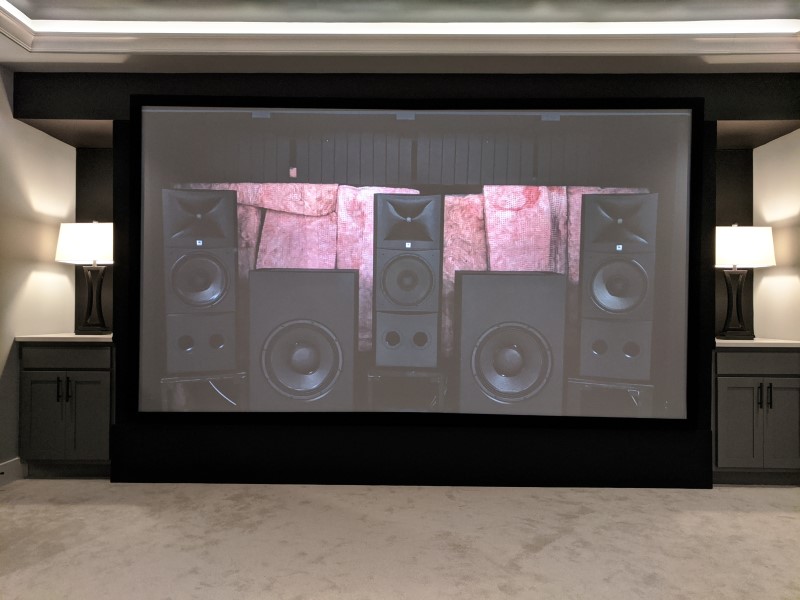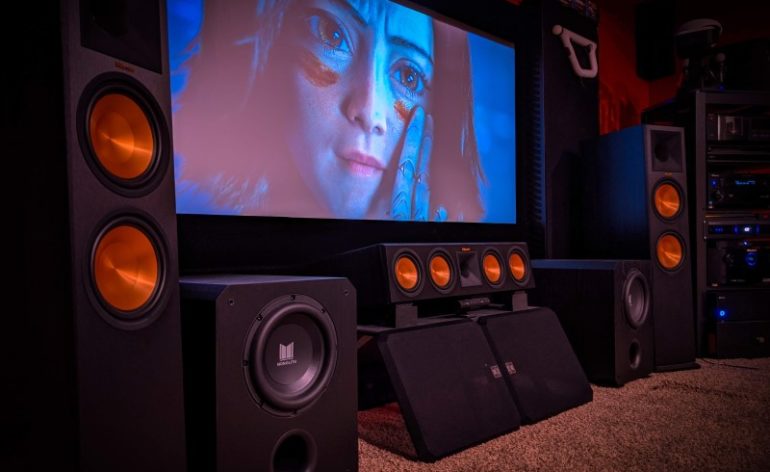Why You Should NOT Get the Largest Possible Projection Screen
We’ve seen it too many times. Someone online posts pictures of an empty room with dimensions. They ask for help setting up their new home theater and they don’t really know where to start. Some “helpful” person declares that, based on the size of the wall, they can fit a projection screen that is, what we like to call, ludicrously large. Yes, we agree, that the screen will fit. But there are just so many reasons NOT to get the largest possible projection screen. Let’s go through a few.
I Love the Smelll of Dramamine in the Morning
Having a huge screen seems like it should have no downsides until you actually sit in front of one. Don’t believe me? Go to a movie theater and sit in the front row. If you can manage to sit there for long without getting nauseated, you have a stronger stomach than me. One of the worst aspects of installing the largest possible projection screen is how it can make you feel. Sick to your stomach? Definitely. But there is more.
When the image is that large, it becomes hard to see what is actually going on. If you only watch dramas with a lot of people looking at each other and crying (I don’t watch many of these so I’m just assuming here), then perhaps a massive screen is fine. But if you want to watch anything with action in it, an overly large projection screen can make it near impossible to understand what is going on. It’s much better to buy the right size TV than to buy the largest projection screen that you can fit.
But there is more.
Eye Strain
Eye fatigue or eye strain is a very real phenomenon. It happens when your eyes are overly taxed. Buying the largest projection screen you can fit will absolutely do this. We’re talking watery and burning eyes. Massive headaches. Sensitivity to light. Eye fatigue can ruin the joy you expected to have in your home theater. All because you measured a wall and said, “Yeah, it’ll fit!”

Have Fun Placing Your Speakers
Maybe you end up with a screen that takes up most of your front wall. Where are you going to put your center speaker? On the floor? And what about your front speakers? They need to be out of the sightlines of your screen which may put them nearly on the side and back walls. That can cause sonic issues plus it can make your front soundstage incoherent. Sure, you may be able to fix some of these issues with room treatments or careful angling of your front speakers, but maybe not. Now your center is too low, your fronts are too wide, and your sound isn’t as good. But, hey! At least you have a huge image, right?
Is Acoustically Transparent the Answer?
I know what you are thinking – acoustically transparent projection screen. You weren’t thinking that? You should have been. It solves the speaker issue. You can place your speakers behind an acoustically transparent screen. Of course, you’ll likely want to install that in a false wall for that “clean” look. Plus, acoustically transparent screens reduce brightness (generally) and universally costs more than traditional screens. How much more. Well…there is more to that…

You Got the Cash, Bro?
Projection screens, even the largest ones, come in standard sizes. You can find some outliers but, in general, you can find 92″, 100″, 120″, and 135″ screens. If you want something outside of one of these, you are going to have to pay a premium. And that premium can get exponentially high very, very quickly. You may measure it out and discover that you can fit a 140″ screen. But that screen might cost ten times the price of the 135″ screen. Why? Because it isn’t being assembled on a line somewhere. Instead, somebody has to custom cut it just for you. They are happy to do it if you are willing to pay.
Now, if you go the acoustically transparent route, you can at least double the cost of the screen in the standard sizes. That’s if you can find one. We’ve been looking for examples for you and we can’t even find one. So, now you are looking at a custom screen that also uses a premium screen material? Hope your wallet is fat!
And before you ask, a DIY screen might save you money, but it probably won’t. Plus, you really going to skimp on the screen when you are going through the trouble of setting up a dedicated home theater? Probably not.
Did You Pay Extra For HDR?
On top of the screen, you need to think about the projector. Most projectors will quote all sorts of maximum screen sizes. And they (mostly) aren’t lying. They can put up an image that large. What they aren’t telling you is that the brightness suffers. If you are buying a newer projector with HDR and all the bells and whistles, you can kiss most of that goodbye at the maximum screen size. Anything bigger than 135″ and most home theater projectors just can’t get bright enough for HDR.
If you want to install the largest projection screen possible, you are going to need to pay a premium for the screen PLUS extra for an extra bright projector. And those projectors? They sometimes need their own dedicated cooling system. So, that probably isn’t cheap either. We don’t know because those projectors are in the realm of “if you have to ask…” and we didn’t ask. Because we can’t afford it.
Tale of the Tape
In the end, there are far more cons than pros when choosing the largest screen that will fit your wall. Sure, you end up with a huge image. But you also end up with compromised speaker placement and sound, headaches and eye strain, a dimmer picture, and paying a whole lot more for all of it. That’s why we always recommend that you decide on an appropriately sized screen for your space. And if that screen is too large for you to afford? Move your seats forward! Now you have an image you can enjoy at a price that doesn’t break the bank.
Do you have a large projection screen or one that you sit very close to? How do you like it? Share in the comments or on our Facebook page!


